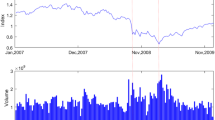Abstract
We propose a new method for creating alternative scenarios for the evolution of a financial time series over short time periods. Using real order book data from the Chi-X exchange, along with a number of agents to interact with that data, we create a semi-synthetic time series of stock prices. We investigate the impact of using both simple, limited intelligence traders, along with a more realistic set of traders. We also test two different hypotheses about how real participants in the market would modify their orders in the alternative scenario created by the model. We run our experiments on 3 different stocks, evaluating a number of financial metrics for intra- and inter-day variability. Our results using realistic traders and relative pricing of real orders were found to outperform other approaches.
Access this chapter
Tax calculation will be finalised at checkout
Purchases are for personal use only
Preview
Unable to display preview. Download preview PDF.
Similar content being viewed by others
References
Arthur, W.B., Holland, J.H., LeBaron, B.D., Palmer, R.G., Tayler, P.: Asset Pricing Under Endogenous Expectations in an Artificial Stock Market. SSRN eLibrary (1996)
Chakraborti, A., Muni Toke, I., Patriarca, M., Abergel, F.: Econophysics: Empirical facts and agent-based models. ArXiv e-prints (September 2009)
Chen, S.H., Chang, C.I., Du, Y.R.: Agent-based economic models and econometrics. The Knowledge Engineering Review, 1–46 (2009)
Chen, S.H., Yeh, C.H.: Evolving traders and the business school with genetic programming: A new architecture of the agent-based artificial stock market. Journal of Economic Dynamics and Control 25(3-4), 363–393 (2001)
Chiarella, C., Iori, G.: A simulation analysis of the microstructure of double auction markets. Quantitative Finance 2(5), 346–353 (2002)
Cohen, K.J., Maier, S.F., Schwartz, R.A., Whitcomb, D.K.: A simulation model of stock exchange trading. Simulation 41(5), 181–191 (1983)
Cont, R.: Empirical properties of asset returns: stylized facts and statistical issues. Quantitative Finance 1(2), 223–236 (2001)
Cristelli, M., Pietronero, L., Zaccaria, A.: Critical Overview of Agent-Based Models for Economics. ArXiv e-prints (January 2011)
Deb, K., Pratap, A., Agarwal, S., Meyarivan, T.: A fast elitist multi-objective genetic algorithm: Nsga-ii. IEEE Transactions on Evolutionary Computation 6, 182–197 (2000)
Engle, R.F.: A general approach to lagrange multiplier model diagnostics. Journal of Econometrics 20(1), 83–104 (1982)
Kim, G., Markowitz, H.: Investment Rules, Margin, and Market Volatility. Journal of Portfolio Management 16(1), 45–52 (1989)
Kirilenko, A.A., Kyle, A.P., Samadi, M., Tuzun, T.: The Flash Crash: The Impact of High Frequency Trading on an Electronic Market. Social Science Research Network Working Paper Series (October 2010), http://ssrn.com/abstract=1686004
LeBaron, B.: Agent-based computational finance: Suggested readings and early research. Journal of Economic Dynamics and Control 24(5-7), 679–702 (2000)
LeBaron, B., Arthur, W., Palmer, R.: Time series properties of an artificial stock market. Journal of Economic Dynamics and Control 23(9-10), 1487–1516 (1999)
Licalzi, M., Pellizzari, P.: Fundamentalists clashing over the book: a study of order-driven stock markets. Quantitative Finance 3(6), 470–480 (2003)
Lux, T., Schornstein, S.: Genetic learning as an explanation of stylized facts of foreign exchange markets. Journal of Mathematical Economics 41(1-2), 169–196 (2005)
Mandelbrot, B.: The Variation of Certain Speculative Prices. The Journal of Business 36(4), 394–419 (1963)
Maslov, S.: Simple model of a limit order-driven market. Physica A: Statistical Mechanics and its Applications 278(3-4), 571–578 (2000)
Palmer, R., Arthur, W.B., Holland, J.H., LeBaron, B., Tayler, P.: Artificial economic life: a simple model of a stockmarket. Physica D: Nonlinear Phenomena 75(1-3), 264–274 (1994)
da Costa Pereira, C., Mauri, A., Tettamanzi, A.G.B.: Cognitive-agent-based modeling of a financial market. In: Proceedings of the 2009 IEEE/WIC/ACM International Joint Conference on Web Intelligence and Intelligent Agent Technology, WI-IAT 2009, vol. 2, pp. 20–27. IEEE Computer Society, Washington, DC (2009)
Russell, J.R., Engle, R.F.: Analysis of high-frequency data. In: Aït-Sahalia, Y., Hansen, L.P. (eds.) Handbook of Financial Econometrics, pp. 383–426. North-Holland, San Diego (2010)
Westerhoff, F., Reitz, S.: Nonlinearities and cyclical behavior: The role of chartists and fundamentalists. Studies in Nonlinear Dynamics & Econometrics 7(4), 3 (2003)
Zigrand, J.P., Shin, H.S., Beunza, D.: Feedback effects and changes in the diversity of trading strategies. The future of Computer Trading in Financial Markets (2011), http://www.bis.gov.uk/assets/bispartners/foresight/docs/computer-trading/11-1221-dr2-feedback-effects-and-changes-in-diversity-of-trading-strategies.pdf
Author information
Authors and Affiliations
Editor information
Editors and Affiliations
Rights and permissions
Copyright information
© 2013 Springer-Verlag Berlin Heidelberg
About this paper
Cite this paper
Panayi, E., Harman, M., Wetherilt, A. (2013). Agent-Based Modelling of Stock Markets Using Existing Order Book Data. In: Giardini, F., Amblard, F. (eds) Multi-Agent-Based Simulation XIII. MABS 2012. Lecture Notes in Computer Science(), vol 7838. Springer, Berlin, Heidelberg. https://doi.org/10.1007/978-3-642-38859-0_8
Download citation
DOI: https://doi.org/10.1007/978-3-642-38859-0_8
Publisher Name: Springer, Berlin, Heidelberg
Print ISBN: 978-3-642-38858-3
Online ISBN: 978-3-642-38859-0
eBook Packages: Computer ScienceComputer Science (R0)




